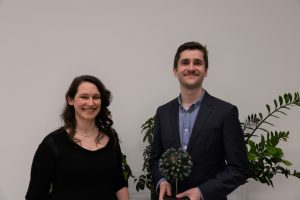
Congratulation, Kristopher, on winning the Lieselotte Templeton Prize for your outstanding Bachelor thesis!
Kristopher started to study biochemistry at the Julius-Maximilians Universität Würzburg in 2017, after first working as a paramedic. He found a special interest in bioinformatics and decided to join the Thorn Lab at the start of 2020. Here he worked in the Corona Virus Structural Task Force, contributing with his data science skills to the fight against the ongoing COVID-19 pandemic. After the Thorn Lab moved from Würzburg to Hamburg at DESY, he started his bachelor thesis investigating the impacts of ice crystal artifacts in macromolecular diffraction data and finding new methods to reliably detect them using artifical intelligence. His work in the Corona Virus Structural Task Force inspired him to use his data science skills to fight infectious diseases. He started his Masters in Health Science and is now working in the ESIDA Project to support the fight against dengue fever.
Please give us an overview of your work.

Detecting the ice diffraction artifacts in single-crystal datasets can be very difficult once the data has been integrated, scaled and merged. Automatic recognition of these artifacts would be highly beneficial as macromolecular structure determination can be negatively impacted or even completely hindered by ice diffraction, but remains difficult.
In 2017, Thorn Lab has shown that the inspection of plots of merged intensities against resolution permit an easy identification of ice ring contamination in integrated data sets [1] – by eye (see figure). However, this approach could be matched by automatic routines. This has led me to attempt identification using machine learning. In the end, I could present convolutional neural networks to detect ice artifacts in processed macromolecular diffraction data, resulting in a new automatic detection called “Helcaraxe”. After my Thesis I have stayed with the research group to further work on the Helcaraxe program and I am immensely proud to have written my first research publication as first author about it [2].
What was the most fun part of your bachelor thesis?
First of all, I was surrounded by wonderful people at DESY and had an incredibly good time working in such a bustling institute. In addition, it was a great pleasure for me to familiarise myself with the topic of machine learning. Even though the term is often used as a buzzword, these models simply have a lot of potential and the possibility to work creatively with data. I especially found the work with Convolutional Neural Networks so stimulating that I will work with them again for my master’s thesis, this time to identify invasive disease vectors.
How did you end up winning the prize?
My mentor and group leader Andrea Thorn told me about this award and nominated me for it. Not only for that am I immensely grateful to her. She has supported me tremendously over the last 2 years and motivated me to pursue my career in science.I am very pleased and honoured that the prize committee has chosen to reward my work with the Liselotte Templeton Prize.
Literature
- A. Thorn, J. Parkhurst, P. Emsley, R. A. Nicholls, M. Vollmar, G. Evans and G. N. Murshudov: AUSPEX: a graphical tool for X-ray diffraction data analysis, Acta Cryst. D 73 729 (2017) 10.1107/S205979831700969X
- K. Nolte, Y. Gao, S. Stäb, P. Kollmannsberger, A. Thorn: Detecting ice artefacts in processed macromolecular diffraction data with machine learning, Acta Cryst D 78 187 (2022) 10.1107/S205979832101202X